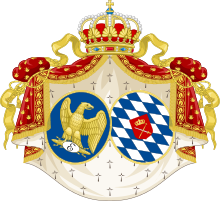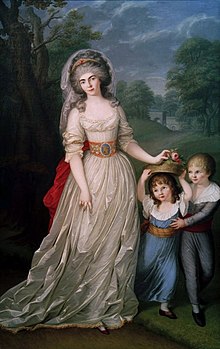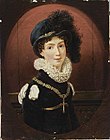| Princess Augusta of Bavaria | |||||
|---|---|---|---|---|---|
| Princess of Venice Grand Duchess of Frankfurt | |||||
 Portrait by Joseph Karl Stieler, c. 1825 Portrait by Joseph Karl Stieler, c. 1825 | |||||
| Viceregal consort of Italy | |||||
| Tenure | 14 January 1806 – 11 April 1814 | ||||
| Duchess consort of Leuchtenburg Princess consort of Eichstätt | |||||
| Tenure | 14 November 1817 – 21 February 1824 | ||||
| Born | (1788-06-21)21 June 1788 Strasbourg, Kingdom of France | ||||
| Died | 13 May 1851(1851-05-13) (aged 62) Munich, Kingdom of Bavaria | ||||
| Spouse |
Eugène de Beauharnais
(m. 1806; died 1824) | ||||
| Issue | |||||
| |||||
| House | Wittelsbach | ||||
| Father | Maximilian I Joseph of Bavaria | ||||
| Mother | Augusta Wilhelmina of Hesse-Darmstadt | ||||

Princess Augusta of Bavaria, Duchess of Leuchtenberg (German: Augusta Amalia Ludovika Georgia von Bayern) (21 June 1788 in Munich – 13 May 1851 in Strasbourg) was the second child and eldest daughter of Maximilian I Joseph of Bavaria and Princess Augusta Wilhelmine of Hesse-Darmstadt. By marriage, she was a French princess and vicereine of Italy. She was the aunt of Empress Elisabeth of Austria and, by marriage, of Emperor Napoleon III.
Early life

Augusta Amalia of Bavaria was the eldest daughter of Maximilian I Joseph of Bavaria and Princess Augusta Wilhelmina of Hesse-Darmstadt. In 1795, upon the death of her uncle, her father Maximilian became the reigning duke of Zweibrücken, but the troops of the young First French Republic occupied his States. Augusta lost her mother to tuberculosis in 1796; a year later, her father married the young Caroline of Baden, who imposed a seriousness on her husband's court that some considered beneficial. At first, Augusta did not like her stepmother, unlike her younger siblings Karl Theodore and Charlotte, as she was still attached to her late mother; however, Augusta and Caroline's relationship improved over time. In 1799, upon the death of his distant cousin Charles Theodore, Maximilian became count-elector, Palatine of the Rhine and Duke-Elector of Bavaria as Maximilian III.
Marriage and issue
Although promised in marriage to the heir of Baden, Charles, originally, the engagement was broken at the behest of Napoleon I of France. He was trying to ally himself with German princes and organized a double marriage: between Augusta and Eugène de Beauharnais, the only son of Josephine de Beauharnais and Alexandre, vicomte de Beauharnais and stepson of Napoleon, and between Charles of Baden and Stéphanie de Beauharnais, Eugène's cousin, who the emperor had adopted and raised with the dignity of an imperial princess. In return, Napoleon raised Bavaria from a state to a Kingdom. The marriage of Augusta of Bavaria and Eugene took place the 13th and 14th of January, 1806. Napoleon attended the wedding. The couple left for Milan the next day,^4 because Eugene had been named viceroy of Italy by his stepfather. Although a diplomatic marriage, this union would turn out to be a happy one.
In 1814, the French Empire fell. Eugene, Augusta, and their children took refuge with the King of Bavaria. In 1817, Augusta's father named his son-in-law Duke of Leuchtenberg and Prince of Eichstädt, with the style Royal Highness. Eugène died young in 1824.
A Catholic, Bavarian princess, the Dowager Duchess of Leuchtenberg opposed in vain the marriage of her younger son, Maximilian, to the eldest daughter of the Tsar of Russia. The Grand Duchess was orthodox and the marriage was unequal, Maximilian not being of royal blood. At the Tsar's demand, the young couple lived in St. Petersburg.
Augusta and Eugène had seven children:
- Princess Joséphine Maximiliane Eugénie Napoléonne de Beauharnais (1807–1876); married Oscar I of Sweden, himself the son of Napoleon's old love, Désirée Clary.
- Princess Eugénie Hortense Auguste de Beauharnais (1808–1847); married Friedrich, Prince of Hohenzollern-Hechingen.
- Prince Auguste Charles Eugène Napoléon de Beauharnais, 2nd Duke of Leuchtenberg (1810–1835); married Maria II of Portugal. There was no issue from this marriage.
- Princess Amélie Auguste Eugénie Napoléone de Beauharnais (31 July 1812 – 26 January 1873); married Pedro I of Brazil (father of Maria II of Portugal and Pedro II of Brazil) and became Empress of Brazil.
- Princess Theodelinde Louise Eugénie Auguste Napoléone de Beauharnais (1814–1857); married Wilhelm, 1st Duke of Urach.
- Princess Carolina Clotilde de Beauharnais (1816)
- Prince Maximilian Josèphe Eugène Auguste Napoléon de Beauharnais (1817–1852); married Grand Duchess Maria Nikolaievna of Russia, eldest daughter of Nicholas I of Russia and received the title of "Prince Romanovsky" with the style "Imperial Highness" in 1852.
Death
Augusta had outlived her husband and three of her children by the time she died in 1851 at the age of 62 in Munich. At that time, France's president was her nephew Louis-Napoléon Bonaparte, the son of Hortense de Beauharnais, Queen of Holland, the sister of Prince Eugène.
Gallery
-
 A young Princess Augusta.
A young Princess Augusta.
-
 Augusta's marriage to Eugène de Beauharnais, by François Guillaume Menageot
Augusta's marriage to Eugène de Beauharnais, by François Guillaume Menageot
-
 Augusta with her daughters Joséphine and Eugénie
Augusta with her daughters Joséphine and Eugénie
-
 Tomb of Augusta of Bavaria
Tomb of Augusta of Bavaria
Honours
 Kingdom of Portugal: Dame Grand Cross of the Order of Saint Isabel, 1 December 1834
Kingdom of Portugal: Dame Grand Cross of the Order of Saint Isabel, 1 December 1834
Ancestry
References
- Abbott, J.S.C. (1856). Confidential Correspondence of The Emperor Napoleon and the Empress Josephine: Including Letters from the Time of their Marriage until the Death of Josephine and also Several Private Letters from the Emperor to his Brother Joseph, and other Important Personages. New York: Mason Brothers. pp. 86–88.
- "Schlossweinstuben Aschaffenburg - Napoleons Zukunftsplanung f?r Aschaffenburg". Archived from the original on 29 November 1998. Retrieved 11 February 2022.
- Abbott, J.S.C. (1856). Confidential Correspondence of The Emperor Napoleon and the Empress Josephine: Including Letters from the Time of their Marriage until the Death of Josephine and also Several Private Letters from the Emperor to his Brother Joseph, and other Important Personages. New York: Mason Brothers. pp. 86–88.
- Weissensteiner, Friedrich (2001). Frauen auf Habsburgs Thron. Die österreichischen Kaiserinnen (in German). Munich: Piper. ISBN 3-492-23033-4.
- La Décade philosophique, littéraire et politique. Au Bureau de la Décade. 1806.
- "LA PRINCESSE AUGUSTE-AMELIE (1788-1814)". Fondation Napoleon. Retrieved 18 November 2024.
- Bragança, Jose Vicente de (2014). "Agraciamentos Portugueses Aos Príncipes da Casa Saxe-Coburgo-Gota" [Portuguese Honours awarded to Princes of the House of Saxe-Coburg and Gotha]. Pro Phalaris (in Portuguese). 9–10: 4. Retrieved 28 November 2019.
External links
![]() Media related to Princess Augusta of Bavaria at Wikimedia Commons
Media related to Princess Augusta of Bavaria at Wikimedia Commons
| Princess Augusta of Bavaria House of WittelsbachBorn: 21 June 1788 Died: 13 May 1851 | ||
| German royalty | ||
|---|---|---|
| Preceded byNone | Duchess of Leuchtenberg 1817–1824 |
Succeeded byMaria Nikolaevna of Russia |
| Bavarian princesses by birth | |
|---|---|
| The generations are numbered from the ascension of Maximilian I Joseph as King of Bavaria in 1806. Only entries with articles are included. Later generations do not legally hold a title due to the German Revolution of 1918. | |
| 1st generation | |
| 2nd generation | |
| 3rd generation | |
| 4th generation | |
| 5th generation | |
| Beauharnais | |
|---|---|
| Generations are numbered from Claude de Beauharnais, seigneur de Beaumont. | |
| 1st generation | |
| 2nd generation | |
| 3rd generation | |
| 4th generation | |
| 5th generation | |
| 6th generation | |
| 8th generation |
|
| * also a Prince or Princess des Francais ** also a Prince or Princess of Leuchtenberg and Eichstädt ^also a Prince Romanovsky or Princess Romanovskaja | |